View in other NatureServe Network Field Guides
NatureServe
Montana
Utah
Wyoming
Idaho
Wisconsin
British Columbia
South Carolina
Yukon
California
New York
Extraordinary Bow-legged Minnow Mayfly - Analetris eximia
State Rank Reason (see State Rank above)
This sand-dwelling mayfly is currently ranked S3 as a "potential species of concern" in Montana because is potentially at risk of extirpation in the state due to limited and/or declining numbers, range and/or habitat, even though it may be abundant in some areas. The specialized habitat this species requires in prairie rivers has been lost with the damming and diverting of our large prairie rivers such as the Bighorn, Tongue, Milk and Marias.
General Description
This swimmer (body-type) mayfly is an inhabitant of large warmwater rivers with shifting sand and gravel substrates. This species is one of the few known predaceous mayflies; they act like tiger beetles on underwater sand bars chasing down prey items, especially chironomids.
Species Range
Montana Range
Range Descriptions
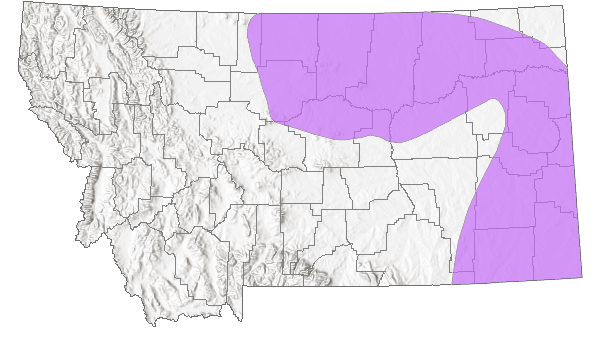
 Native
Native
Range Comments
This species is confined to a highly specific habitat, is difficult to sample, and is limited to the Saskatchewan, Upper Colorado, and Upper Missouri River Drainage systems; and recently in Montana (MT NHP, March 2006) and North Dakota (Guenther and McCafferty, 2005).
Observations in Montana Natural Heritage Program Database
Number of Observations: 33
(Click on the following maps and charts to see full sized version)
Map Help and Descriptions
Relative Density
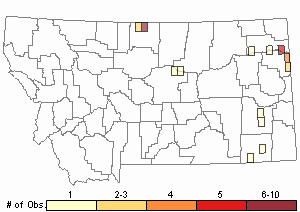
Recency
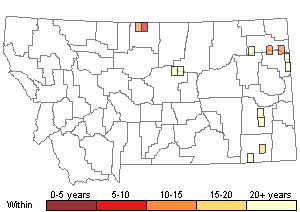

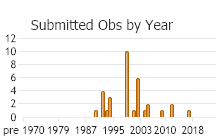
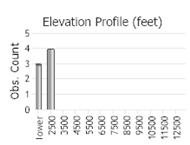 (Observations spanning multiple months or years are excluded from time charts)
(Observations spanning multiple months or years are excluded from time charts)
Habitat
This species is associated with larger, perennially flowing prairie rivers with shifting sand-gravel dominated bottoms with cobble riffles
Food Habits
This is one of the few known predacous mayflies, they act like tiger beetles on underwater sand bars chasing down prey items. Chironomid midges and blackflies probably make up a large part fo their diet.
Stewardship Responsibility
Threats or Limiting Factors
All forms of stream quality degradation pose potential threats to these large river dwellers. These include siltation; pollution from agricultural and industrial waste; and hydrological alteration from drainage, dams, or withdrawal of excess water for human use.
References
- Additional ReferencesLegend:
 View Online Publication
View Online Publication
Do you know of a citation we're missing? Guenther, J.L. and W.P. McCafferty. 2005. Mayflies (Ephemeroptera) of the Great Plains. III: North Dakota. Transactions of the American Entomological Society, 131(3-4): 491-508.
Guenther, J.L. and W.P. McCafferty. 2005. Mayflies (Ephemeroptera) of the Great Plains. III: North Dakota. Transactions of the American Entomological Society, 131(3-4): 491-508. Hendricks, P., S. Lenard, D.M. Stagliano, and B.A. Maxell. 2013. Baseline nongame wildlife surveys on the Fort Peck Indian Reservation. Report to the Assiniboine and Sioux Tribes of the Fort Peck Indian Reservation. Montana Natural Heritage Program, Helena, MT. 83 p.
Hendricks, P., S. Lenard, D.M. Stagliano, and B.A. Maxell. 2013. Baseline nongame wildlife surveys on the Fort Peck Indian Reservation. Report to the Assiniboine and Sioux Tribes of the Fort Peck Indian Reservation. Montana Natural Heritage Program, Helena, MT. 83 p. Stagliano, D.M. 2016. Mayflies (Insecta: Ephemeroptera) of conservation Concern in Montana: Status Updates and Management Needs. Western North American Naturalist 76(4):441-451.
Stagliano, D.M. 2016. Mayflies (Insecta: Ephemeroptera) of conservation Concern in Montana: Status Updates and Management Needs. Western North American Naturalist 76(4):441-451.
- Web Search Engines for Articles on "Extraordinary Bow-legged Minnow Mayfly"
- Additional Sources of Information Related to "Insects"





